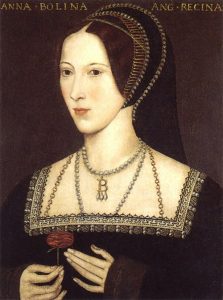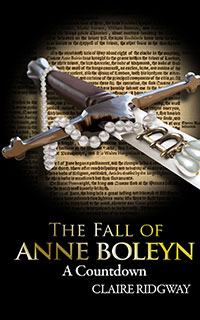 On 10th May 1536, Giles Heron, foreman of the Grand Jury of Middlesex and son-in-law of the late Sir Thomas More, announced that the jury had decided that there was sufficient evidence to suggest that Anne Boleyn, George Boleyn, Mark Smeaton, Sir Henry Norris, Sir Francis Weston and Sir William Brereton were guilty of the alleged crimes carried out at Hampton Court Palace and Whitehall, and that they should be indicted and sent to trial before a jury.
On 10th May 1536, Giles Heron, foreman of the Grand Jury of Middlesex and son-in-law of the late Sir Thomas More, announced that the jury had decided that there was sufficient evidence to suggest that Anne Boleyn, George Boleyn, Mark Smeaton, Sir Henry Norris, Sir Francis Weston and Sir William Brereton were guilty of the alleged crimes carried out at Hampton Court Palace and Whitehall, and that they should be indicted and sent to trial before a jury.
I go into full details on the indictment in my book but the language used in the indictment aimed to shock. Anne Boleyn was described as “seduced by evil”, as having malice in her heart, and having “frail and carnal appetites”. The indictment also went into detail on the incest charge, accusing Anne of seducing her brother George by “alluring him with her tongue”.
Five men were named as committing adultery with the Queen – Sir Henry Norris, Mark Smeaton, Sir Francis Weston, Sir William Brereton and George Boleyn, Lord Rochford – and they were also all accused of conspiring to kill the King. The indictment ended with the words “And thus the said Queen and the other traitors aforesaid have committed their treasons in contempt of the Crown, and of the issue and heirs of the said King and Queen”.
Also, on this day in 1536, Sir William Kingston, the Constable of the Tower of London, was ordered “to bring up the bodies of Sir Francis Weston, knt. Henry Noreys, esq.William Bryerton, esq. and Mark Smeton,gent. at Westminster, on Friday next after three weeks of Easter”, i.e. on 12th May. This would be the day of their trial.

Yikes! I know in Tudor times, that phrase might have meant something different, but in OUT timeframe, “bring up the bodies” sounds not only ominous, but prophetic, as well.
What other evidence, I wonder, was brought against the accused? The actual “meant to kill the king” and Anne’s “indecent and vile” behavior sound more like the result of gossip – either something already whispered around court, or something manufactured to frame the accused.
Claire, we need to finish that time machine. I would LOVE to see you take on Anne’s case, and unleash Clare Cherry on George Boleyn’s detractors!
It’s a horrible phrase, isn’t it? Both Alison Weir and Eric Ives point out that this order was sent before the meeting of the Grand Jury in Kent and may even have been sent before the Middlesex meeting, so it was assumed that the Grand Juries would order their trials.
The indictments accused Anne of giving the men “great gifts to encourage them in their crimes”, but obviously it was perfectly normal for a Queen to reward courtiers. Normal everyday things and examples of the courtly love tradition were twisted as evidence, it was horrible. The Countess of Worcester allegedly mentioned Smeaton and George when she spoke to her brother about Anne’s behaviour, but that was it. It seems that Smeaton may have implicated Norris and that Anne’s ramblings in the Tower implicated Weston, but Brereton must have been chosen for purely political motives, to get him out of the way.
I think the expression “the fix was in” is very apt here. The evidence was fixed and they never stood a chance.
Would so love to see her retried and proven innocent. Maybe she would get the honor she deserves.one of my favorite people in history.
Claire great read as always,what a morbid thing to do to the dead men,who we all no died in vain! Reading the site on the letters ,it was said that Queen Annes head was put on a spike for weeks,any truth to this??? Also the second book is so far Fab!!I can’t put it down,and intend on read, both for a second or third time,or more.Will there be another book?? You are trulely a Great Author Claire. Sincerly Baroness